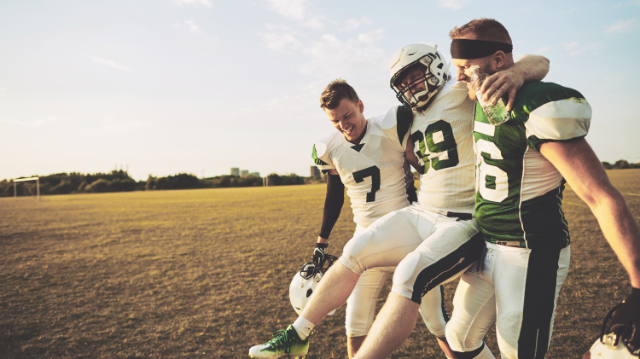News
A Review Of Physical Therapy Tactics For Common Injuries In Sports

In our last post, we answered some of the most frequently asked questions about physical therapy and sports–related injuries. Now, we’re going to take a closer look at the specific components of physical therapy programs for several common injuries in sports to give you a better sense of what to expect if you’re considering treatment.
Ankle sprains
As we mentioned in the first post, ankle sprains are often regarded as the most common injury in sports, with high rates seen particularly in basketball and soccer due to the frequent cutting movements involved. A typical physical therapy program for these injuries will include the following:
- RICE, which stands for rest, ice, compression, and elevation, is a crucial first step for managing symptoms in the first few days after the sprain
- Range of motion exercises are designed to restore normal ankle movement with gentle motions
- Strengthening exercises will help patients regain their strength and prevent longterm ankle disability
- Balance training will help improve patients’ stability and teach them how to deal with potential hazards during activity
- Functional training focuses on movements and actions that are specific to one’s sport
Lower back strain
A lower back strain can develop due to different mechanisms in many sports. Pushing and pulling sports—like football—as well as sports that require sudden twisting of the lower back—like tennis, basketball, and golf—are all associated with an increased risk for lower back strain. Physical therapists generally approach these injuries with the following:
- Individualized stretching exercises for the lower back muscles, abdominal muscles, hips, and legs are often recommended as an initial first step to improve flexibility
- Core strengthening exercises focus on the abdominal and lower back muscles to better reinforce the spine
- Dynamic stabilization exercises, which often utilize exercise balls or other devices, are intended to strengthen the secondary muscles of the spine
- Manual therapy, a specialized form of physical therapy in which the therapist uses their hands to apply pressure to muscle tissue and manipulate joints to alleviate back pain
Calf, hamstring, and groin strains
Strains of various leg muscles are quite common in several sports. Calf strains and hamstring are most likely to occur in sports that involve lots of running or high speeds, like soccer, basketball, tennis, and football, while groin strains tend to occur from kicking or turning suddenly, with high rates seen in soccer and ice hockey. Physical therapy for these muscle strains will typically consist of the following:
- Pain–relieving modalities like ice, heat, ultrasound, and taping
- Manual therapy that gently moves and manipulates the affected muscles and surrounding joints reduce pain and improve physical function
- Strengthening exercises intended to build back strength of the calf, hamstring, or groin and any other muscles that may have become weakened through injury
- Range of motion exercises, which typically begin later in the program—especially for hamstring strains—to increase lost flexibility
- Functional training, which is based on the key movements involved in the athlete’s sport
Plantar fasciitis
Plantar fasciitis is the most common cause of heel pain in adults, and it is especially common in long–distance running and hiking. Physical therapy generally includes these interventions:
- Pain–relieving modalities: heat, ultrasound, and icing the bottom of the foot can all lead to immediate pain relief
- Stretching and strengthening exercises to target the calves, ankle, and foot, including the plantar fascia
- Foot taping and/or a night splint to provide support for the arch of the foot
- Manual therapy techniques to release muscle tension in the foot and surrounding area and reduce pain
- Footwear education, in which the therapist will guide you on how to select the right pair of shoes to reduce stress on the plantar fascia
Rotator cuff and shoulder pain
Shoulder pain is extremely common in sports that involve overhead throwing—like baseball, softball, and football—as well as swimming and tennis. Most causes of shoulder pain involve the rotator cuff, with shoulder impingement, rotator cuff tendinitis, and rotator cuff tears being the most common culprits. Physical therapy for these injuries will usually include:
- Pain–relieving modalities like ice, heat, and electrical stimulation
- Manual therapy techniques like gentle joint movements, soft–tissue massage, and shoulder stretches to gradually improve the shoulder’s movements
- Posture education that teaches patients ideal sitting, standing, and sleeping positions to reduce pain levels
- Functional training based on the athlete’s sport or activity Stretching and strengthening exercises for weak or inflexible muscles
If you’ve recently sustained an injury in sports, we strongly encourage you to come in for a visit so we can get you started on a treatment program right away. Contact us for more information.
Disclaimer:
The information in the articles, posts, and newsfeed is intended for informational and educational purposes only and in no way should be taken to be the provision or practice of physical therapy, medical, or professional healthcare advice or services. The information should not be considered complete or exhaustive and should not be used for diagnostic or treatment purposes without first consulting with your physical therapist, occupational therapist, physician or other healthcare provider. The owners of this website accept no responsibility for the misuse of information contained within this website.
